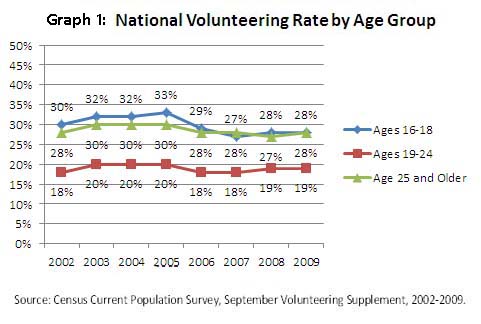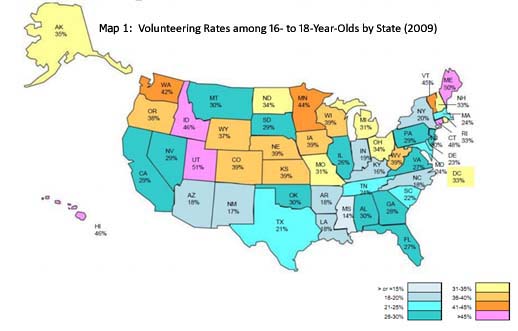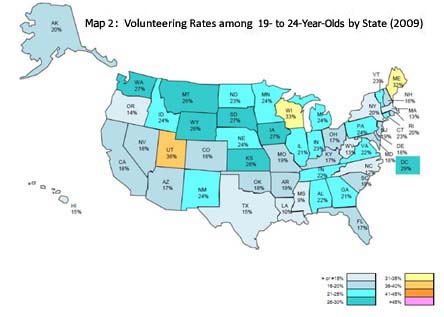Volunteering/Community Service
On This Page
- Benefits of Volunteering
- Volunteering Trends & Statistics
- Where Young People Volunteer
- Motivations for Volunteering
- How to Encourage Volunteering Among Young People
- What Young People think about New Volunteer Programs and Policies
- Resources
Benefits of Volunteering
A fact sheet by Davila and Mora investigates the effect of school required community service on academic performance. The authors found positive links between the two, providing solid research for community service advocates.
- Students who participated in school required community service were 22 percentage points more likely to graduate from college than those that did not and were more likely to have improved their Reading, Math, Science, and History scores.
- Similarly, students who performed voluntary community service were 19 percentage points more likely to graduate from college than those that did not.
Read more results about the positive link between civic engagement and educational attainment here.
A CIRCLE working paper by Andrea Finlay and Constance Flanagan finds a link between educational progress and volunteering for young adults (after high school age).
A CIRCLE fact sheet finds that volunteering also seems to ease the transition to civilian life for returning veterans.
Volunteering Trends & Statistics
The actual rate of youth “volunteering” is controversial, because definitions of the term vary and each survey produces different levels. Probably the most reliable estimate comes from the Census annual Current Population Supplement, as analyzed by CIRCLE. (See Fig. 1 below.) These data suggest that the volunteering rate for young adults is around 19%, although other surveys yield higher rates. All surveys find a gap in the volunteering rate between those who attend college and those who do not.

- The volunteering rate among Americans of high-school age (16-18) hit its peak in 2005, at 33%, but has since declined to 27-29% for the past four years.
- Considering that the average volunteering rate between 2002 and 2005 was 32% for the same age group, the recent figures are cause for some concern because it may mean that high schools may not be offering opportunities for students to serve at the same rate as they once did or that there are fewer places in the communities for youth to serve.
Source: Youth Volunteering in the States: 2002 to 2009

- According to CIRCLE’s own 2006 Civic and Political Health of the Nation, 36% of young people, ages 15 to 25, volunteered in the past year.
- Of these young volunteers, only 19% reported volunteering on a regular basis.
Volunteering rates by student status:
- Current high school student: 47%
- Current college student: 43%
- Not a current student: 23%
Volunteering rate by state AND age group:
Ages 16-18
 In 2009, the volunteer rate for 16-to-18 year-olds ranged greatly across the country. This age group volunteered at the highest rates in 2009 in Utah (51%), Maine (50%), Connecticut (48%), Hawaii (46%), Idaho (46%) and Vermont (45%).
In 2009, the volunteer rate for 16-to-18 year-olds ranged greatly across the country. This age group volunteered at the highest rates in 2009 in Utah (51%), Maine (50%), Connecticut (48%), Hawaii (46%), Idaho (46%) and Vermont (45%).- The state with the lowest levels of volunteerism among 16-to-18 year-olds was Mississippi (14%).
- The national volunteer rate for 16-to 18-year-olds trended upward from 30% to 33% between 2002 and 2005, but it declined by five percentage points between 2005 and 2009.
- Volunteer rates for young adults (19- to 24-years old) in 2009 were generally lower. For this group, the states displaying the highest volunteer rates in 2009 were Utah (36%), Wisconsin (33%), Maine (32%), the District of Columbia (28%), and Iowa (27%).
- The national rate of volunteering for 19-to 24-year-olds increased one percentage point between 2002 and 2009 to 19%
- For those age 25 and older, 2009 volunteer rates ranged from 46% in Utah to 20% in New York.
- The overall rate of volunteer activity in the age 25 and above population remained unchanged from 2002 to 2009 (28%).
Where Young People Volunteer
Organizations involving youth (67%) draw the greatest numbers of young volunteers, followed by civic or community organizations (54%) and then religious groups (49%). Political organizations tend to draw the fewest youth volunteers (13%).
Source: 2006 Civic and Political Health of the Nation
Wyoming, Utah, and Wisconsin had the three highest youth volunteer rates in 2005.
Source: CIRCLE’s tabulations from the Current Population Survey, September Supplement, 2005.
Motivations for Volunteering
- Overall, young people who participated in political organizations (just 13% of the young volunteers) were most likely to be motivated by the desire to address a social or political problem.
- Most young people who volunteered for other types of organizations wanted to help other people. For example, young people who volunteered for environmental organizations generally did so to help other people (52%), not to address a social or political problem (23%).
Source: 2006 Civic and Political Health of the Nation
How to Encourage Young People to Volunteer
Invitations please…
Being asked is the top reason motivating young people to volunteer (closely followed by “because it makes me feel good.”) In 2006, political organizations were also the most likely to recruit their volunteers by reaching out to them. In the other groups, young volunteers tended to make the initial contact.
Role Models…
Young people who grow up in a household where someone volunteers are twice as likely to volunteer regularly, to be an active member of a group, and are more likely to follow politics and vote.
Let’s Discuss!
Young people who discuss a volunteer experience are twice as likely as others to volunteer regularly. And, they are also 16 percentage points more likely to try to influence someone’s vote!
Sources: The Civic and Political Health of the Nation: A Generational Portrait & 2006 Civic and Political Health of the Nation
What Young People think about New Volunteer Programs and Policies
Young adults are enthusiastic about an expanded AmeriCorps type program – where every young person would be offered a chance to do a full year of community service to earn money for tuition.
However, the majority of young people oppose community service as a requirement for high school graduation. Source: Volunteering Among Young People
1 It is important to note that in recent years efforts to measure volunteering have produced widely different estimates, largely because of the methods employed to measure volunteering.
Resources
For more information on volunteering/ community service:
Consensus Report:
The Civic Mission of Schools (released by CIRCLE & Carnegie Corporation of New York)
Fact sheets:
2007
- An Assessment of Civic Engagement and Educational Attainment
- Volunteering Among Young People
- Volunteering Among High school students,
- College Experience and Volunteering
- Volunteering Among Non-college Youth
- Youth Volunteering in the States: 2002 to 2006
2005
2004
2002
- Youth Attitudes Towards Civic Education and Community Service Requirements
- Civic Engagement Among Minority Youth
Working Papers:
2009
- Predicting Civic Engagement in Urban High School Students
- Making Educational Progress: Links to Civic Engagement During the Transition to Adulthood
2008
- Civic Engagement and the Disadvantaged: Challenges, Opportunities and Recommendations
- Do Race, Ethnicity, Citizenship and Socio-Economic Status Determine Civic-Engagement?
2007
- Civic Engagement and High School Academic Progress: An Analysis Using NELS
- Do Gender and Ethnicity Affect Civic Engagement and Academic Progress?
2003
Research Report:
The 2006 Civic and Political Health of the Nation Report
Last Updated: 1/9/2012






